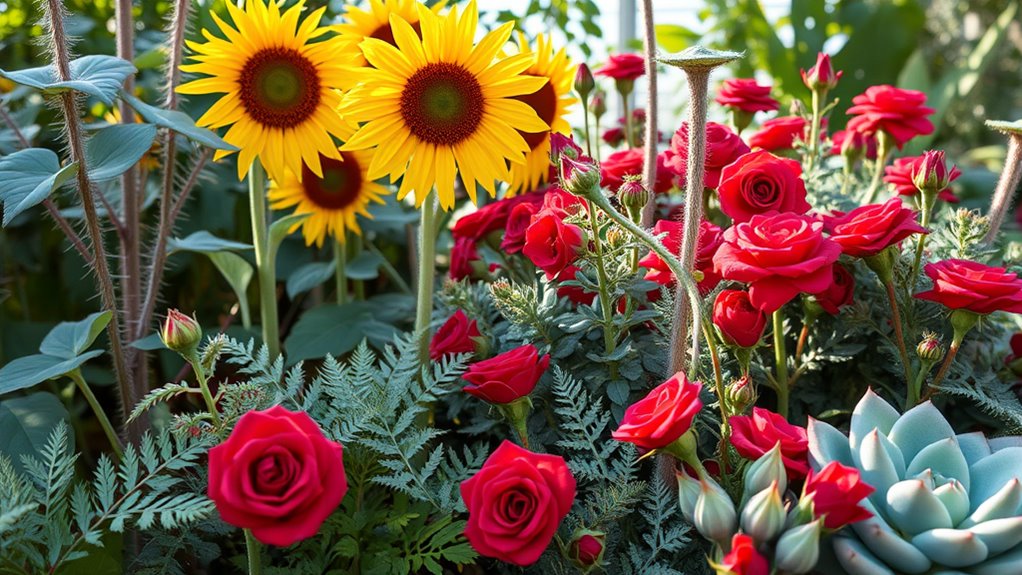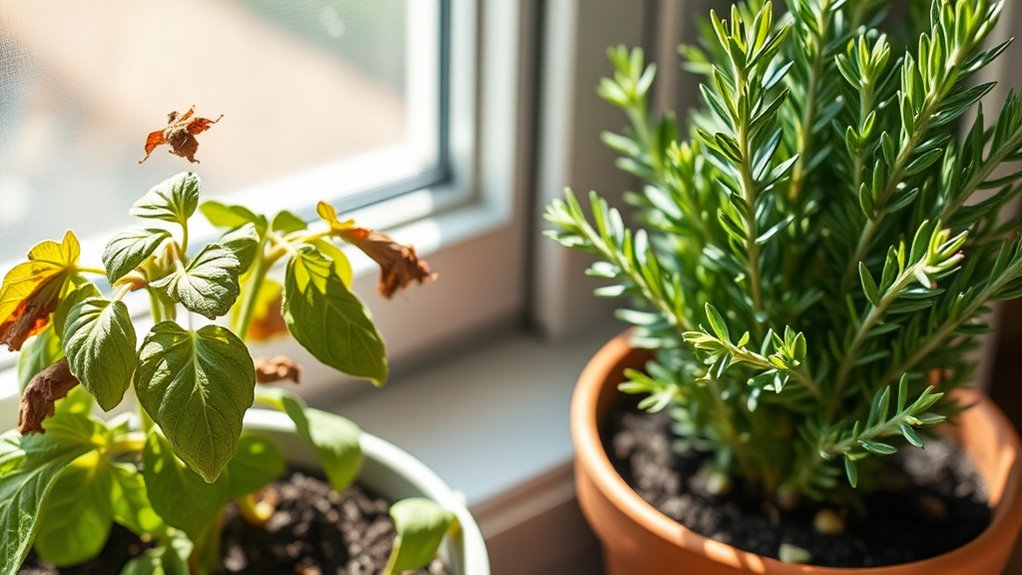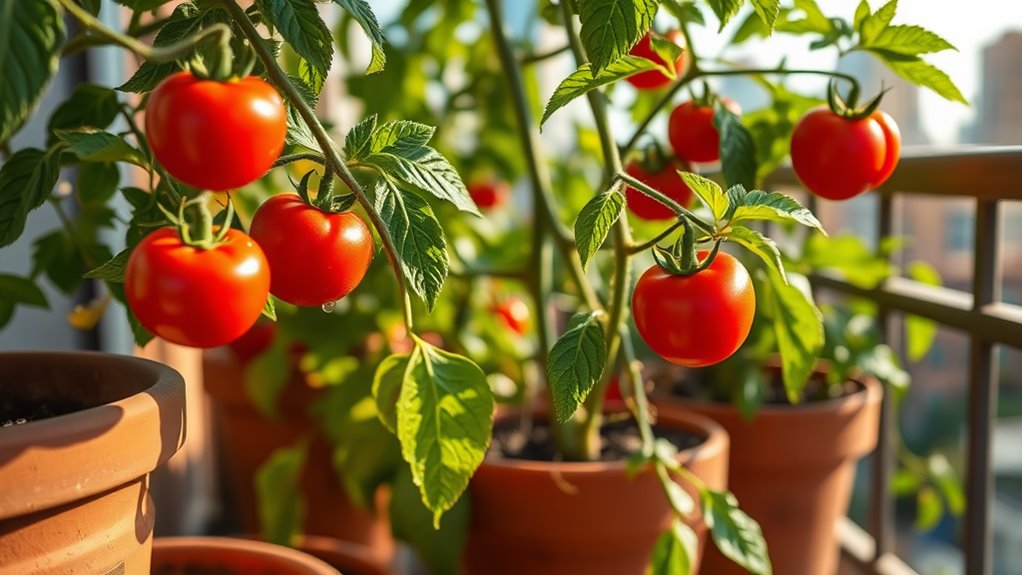My Low-Maintenance Herb Garden That Basically Grows Itself
You can easily build a low-maintenance herb garden with tough plants like rosemary, thyme, and oregano that thrive on minimal water and sunlight. Pick a sunny spot with good drainage, enrich your soil with compost, and space plants for easy growth. Water deeply once a week and use natural pest control, like releasing ladybugs, to keep things pest-free. Harvest fresh herbs in the morning for the best flavor, and you’ll find even more ways to simplify your setup ahead.
Key Takeaways
- Choose low-maintenance herbs like rosemary and thyme that thrive with minimal watering and pruning.
- Select a sunny spot with well-drained soil, enriched by compost, for easy growth.
- Plant herbs in prepared soil and use deep watering once a week to sustain them effortlessly.
- Manage pests naturally by introducing beneficial insects like ladybugs to keep the garden balanced.
- Harvest herbs in the morning and store by drying or freezing for simple, year-round use.
Selecting Low-Maintenance Herbs
When you’re building a low-maintenance herb garden, selecting the right herbs sets the foundation for easy success. You should prioritize low effort herbs like rosemary, which thrives in dry soil with minimal watering and resists pests naturally.
Thyme spreads quickly but needs little pruning, while oregano grows vigorously in poor conditions without much intervention. Mint is hardy and fast-growing, though you’ll want to contain it to avoid over-spreading.
Chives and lavender are also ideal low effort herbs, requiring infrequent care and offering robust flavors. By focusing on these resilient options, you’re ensuring a garden that flourishes with ease. These herbs are ideal for indoor cultivation, providing fresh flavors for year-round use. To further enhance your garden, explore the nine resilient herbs that thrive with minimal care.
Choosing the Perfect Spot
Where’s the best spot for your low-maintenance herb garden?
You’ll want a location that maximizes sunlight while minimizing effort. Aim for a spot with at least six hours of direct sun daily, as herbs like basil and rosemary thrive in bright conditions. This ensures robust growth without constant tending. Ensuring your garden gets full sun is crucial for the herbs’ essential oil production.
-
Prioritize sunlight: Select an area that gets full sun to keep herbs healthy and flavorful.
-
Consider accessibility: Place it near your kitchen or patio for easy harvesting and maintenance.
-
Protect from elements: Choose a sheltered spot away from strong winds to prevent damage and reduce stress on plants.
Additionally, for those with limited space, container gardening can make it simple to cultivate flavorful herbs.
Preparing Your Soil Basics
Before you plant your herbs, test your soil to determine its pH and nutrient levels, which helps you identify any adjustments needed for optimal growth.
Once you’ve reviewed the results, add compost to enrich the soil, boosting its organic matter and drainage for healthier roots.
This simple step ensures your garden bed supports thriving herbs with minimal effort.
Additionally, performing soil testing allows you to identify and remedy potential issues that could lead to garden failure.
Moreover, soil testing can enhance plant health and boost yields for a more successful herb garden.
Soil Testing
Soil testing is your first smart move in preparing the soil for a low-maintenance herb garden, as it reveals essential details like pH levels, nutrient content, and drainage.
You’ll save time and effort by knowing your soil’s exact needs before planting. Use a reliable test kit or local lab to get accurate results quickly, ensuring your herbs thrive with minimal intervention.
-
Choose the right test kit: Opt for one that measures pH and key nutrients for immediate, easy results.
-
Sample correctly: Dig from multiple spots at 6-8 inches deep to get a representative soil mix.
-
Interpret findings: Understand if your soil is acidic, alkaline, or balanced to plan your garden layout effectively.
Add Compost
After assessing your soil’s needs from testing, you’ll enhance it by adding compost, which boosts nutrients, improves drainage, and creates a fertile base for your low-maintenance herb garden.
Start by selecting high-quality, well-rotted compost—either homemade or store-bought organic varieties. Spread a 2-4 inch layer evenly across your bed, then mix it into the topsoil using a fork or tiller for thorough incorporation.
This step retains moisture, suppresses weeds, and fosters beneficial microbes, minimizing future upkeep. Aim to add compost annually in spring for sustained vitality, ensuring your herbs flourish effortlessly with this simple boost.
Simple Planting Steps
Once you’ve selected your herbs, planting them is straightforward and requires just a few key steps to ensure a thriving, low-maintenance garden. Incorporating soil preparation is essential for fostering overall garden health as per beginner gardening tips.
Begin by preparing the soil: loosen it to a depth of 12 inches and mix in the compost. To enhance soil health, consider using compost made from kitchen scraps. Dig holes twice the size of the root balls, spaced according to each herb’s mature size. Gently remove herbs from their pots, place them in the holes, and firm the soil around the roots to secure them.
- Choose a sunny location for optimal growth.
- Handle roots carefully to avoid damage.
- Label plants for easy identification.
Easy Watering Strategies
You can set up drip irrigation in your herb garden to deliver water efficiently to plant roots, minimizing waste and effort on your part.
Explore self-watering methods like containers with built-in reservoirs, which let you maintain consistent moisture without daily checks.
These approaches help you keep your herbs thriving while cutting back on routine maintenance, and by adopting deep watering once a week, you can ensure soil moisture effectively reaches the roots for better plant health.
Additionally, incorporating an innovative watering schedule can maximize efficiency, save water, and enhance garden health and productivity.
Drip Irrigation Tips
Drip irrigation simplifies watering your herb garden by delivering moisture directly to plant roots, reducing waste and effort.
It’s ideal for herbs like basil and thyme, as it maintains consistent soil moisture without soaking leaves, which prevents fungal issues.
You’ll save time and water, making your garden thrive with minimal intervention.
-
Select the right setup: Choose emitters based on your herbs’ needs, like low-flow for smaller pots, to ensure even distribution.
-
Install efficiently: Lay tubing along rows and secure with stakes; connect to a hose for quick setup in under an hour.
-
Maintain regularly: Check lines weekly for blockages and adjust flow rates to match weather, keeping your system reliable.
Self-Watering Methods
Self-watering methods offer a hands-free way to keep your herb garden thriving, using simple setups like wicking systems or capillary mats that draw water from reservoirs directly to roots.
To get started, you’ll drill a hole in a container for a wick—such as a cotton string—linking it to a water-filled reservoir below your pots.
For capillary mats, place them in a tray under your herbs; they’ll absorb and release moisture as needed, preventing root rot in basil or thyme.
This saves time and resources, letting you focus on harvesting. You’ll monitor reservoir levels bi-weekly, ensuring consistent growth with minimal intervention, even during vacations.
Managing Common Pests Naturally
Maintaining a healthy herb garden means tackling common pests like aphids and spider mites head-on with natural strategies, which protect your plants without harsh chemicals.
You’ll spot these pests early by checking leaves regularly, then apply gentle solutions to keep them at bay.
Furthermore, incorporating herbs such as basil or rosemary can leverage their natural pest-repelling qualities to enhance natural pest management.
Additionally, incorporate easily accessible staples from your kitchen, such as garlic or vinegar, to bolster these natural pest control efforts and foster a thriving garden ecosystem.
-
Introduce beneficial insects****: Release ladybugs or lacewings to naturally prey on aphids, reducing infestations effortlessly.
-
Use homemade sprays****: Mix neem oil with water and a dash of soap; spray it directly on affected areas for effective control.
-
Promote plant health: Encourage strong growth with companion planting, like basil near tomatoes, to deter pests naturally.
Harvesting and Using Your Herbs
Once your herbs are pest-free, you’ll want to harvest them at the peak of their freshness to maximize flavor.
Pick leafy varieties like basil in the morning before flowering, using sharp shears to snip stems just above a leaf node for regrowth. For woody herbs like rosemary, trim lightly throughout the season to encourage bushiness.
To use your herbs, rinse them under cool water and pat dry immediately.
Chop fresh ones into salads, soups, or teas for optimal taste.
Dry excess by bundling and hanging in a warm, ventilated area, then store in sealed jars.
Freeze portions in oil for easy year-round use, adding zest to your meals effortlessly.





